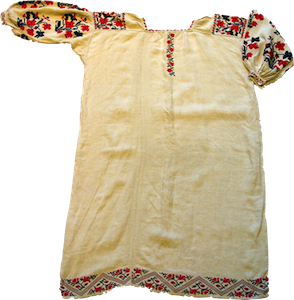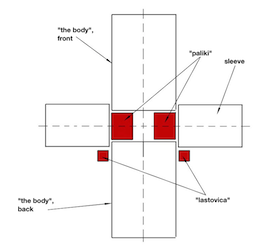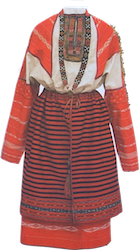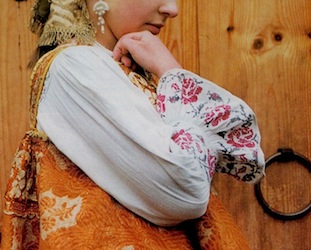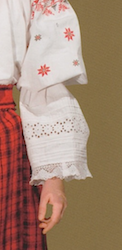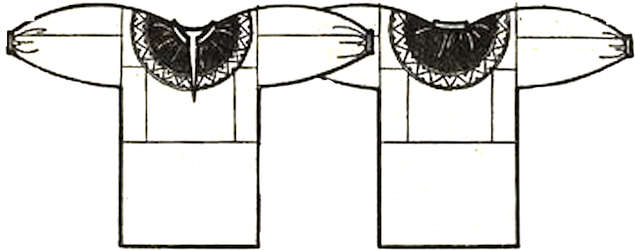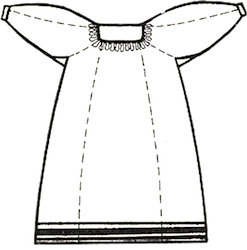
| Outfits >>> Read about >>> Woman's Shirt (Underdress). | |||||||||||||||||||||
|
A cut of a chiton-like shirt is simple. A rectangular piece of cloth is folded half-by-half across a warp (along a woof). On the fold line they make an oval hole for a neck, and a long cut on a front part of a shirt. A shirt for woman always was an ankle-long (as a dress). The idea of a hip-long shirt (as for modern shirts and t-shirts) appeared in Russian tradition around 1900s (see below). Woman's everyday shirt had been made of unbleached home woven linen, hemp, or (for an extremely poor woman) from a motley (motley is a cloth made of fibers of a different type, color, length - in fact, of a thread garbage). Speaking of festive shirts, people applied expensive and fashioned-looking materials for them: silk, fabric-made cotton, bleached linen. For traditional shirts, people did not cut a costume in a contemporary meaning of a word "cut" (nobody really cut smaller pieces of cloth from a larger one). Instead, people calculated a size of a desired detail, and wove this detail in accordance with calculation (it needs to be noticed that ALL details of a traditional Russian shirt are rectangular - no exceptions. OK, there IS one exception, see below).
The "combined rectangles" fashion looks simple and obvious, but, nevertheless, several types of this "combined rectangles" design existed. These are the most common of them:
Rectangles were attached to each other using a seam different from modern "overlapping" one. The village seam was: you put linen rectangles side-by-side, let their sides touch each other slightly, and sew them in this 'barely touching' position. However, this seam was used for everyday shirts only. For ritual outfits, villagers applied other sewing techniques (more archaic ones). For instance, Siberian old-believers used a technique termed as "needle lace". Linen rectangles did not touch each other at all. They kept approximately 1-inch gap between them. And, this gap was filled by a combination of long and loose stitches (mostly, these stitches were combined in a certain design - that's why people called it "lace"). Sure, such a seam was very fragile - but, it was enough for one day / half a day of a ritual. Siberians used this "needle lace" technique until 1960s (one of our team member saw samples of it in late 1990s).
In general, Russian (and, more broadly, Slavic) woman's shirt has a rectangular paliki (shoulder details). However, some regions developed a very specific fashion with "triangular paliki". Scientists believe this fashion was adopted from Polovtsi (Kipchaks in English) - herders' tribe neighbored Russians in some regions of Southern Steppes. Traditionally, paliki should be heavily decorated with embroidery. Originally, this embroidery represented 'signs of a tribe'. Each region of Russia had its own motifs, and, moreover, these motifs altered from village to village. In fact, it was 'a message to ancestors': 'this woman is your descendant, please protect her'. This archaic meaning and purpose of paliki as 'a tribal marker' was almost forgotten to 1880s. For the most ancient shirts, embroidery is applied for paliki only: sleeves were plain white. However, circa 1850s, village people realized (due to close contacts with their noble masters) that needlepoint could be not only sacral symbols, but a fancy decoration also. So, sleeves started to be 'a showcase': each woman wanted to demonstrate her proficiency in embroidery by decorating sleeves. At first, craftswomen used the same traditional designs as for paliki. But later, sleeve's embroidery became 'just embroidery' (especially, in Southern Russia). Shirts of adolescent girls should have a very fancy cuffs, mostly in a shape of a morning-glory. Such cuffs symbolized that a girl is mature enough to be married ('this flower started blooming - hey, bees, welcome!'). Cuffs could be extremely long or wide, and a rich decoration was mandatory. It could include ribbons, lace, and, of course, embroidery (symbols of Tree of Life, flowers, tree branches).
In Southern Russia (where people worn a poneva-style outfit), tradition required to decorate heavily not only paliki, but also a hemline of a shirt. This requirement was in use until 1910s. At the same time, in Northern Russia ( a sarafan-style outfit), people stopped decorating hemlines of shirts circa 1750s. The reason was purely economic: at 1750s, Northern sarafans were transformed from front-bottom-opened feryaz into closed-bottom klinnik. So, villagers did not want to decorate non-visible parts of an outfit.
One more economically-caused change of a shirt was invention of a rukova ('sleeves-only') design. A woman took a small piece of an expensive an fancy-looking cloth, and made a short top. Paliki and sleeves of this top were heavy decorated with embroidery, applique, and, sometimes, pearls and gemstones. To make this top ankle-long, a woman carelessly attached a long piece of a cheap cloth to the top. To wash a shirt, a woman just detached a cheap bottom, and wash it separately (decorative tops have been washing very rarely, and with extreme caution). Also, it was easy to replace a cheap bottom part, if necessary.
After 'sleeves-only', a hip-bottom shirt was invented in 1900s. Along with length, the whole cut was changed also. People started using a yoke, and 'no-paliki' design (similar to modern raglan sleeves).
Note that ritual shirts persisted to be extremely archaic in cut and decoration until 1940s.
| |||||||||||||||||||||
Sources (in Russian)
|
